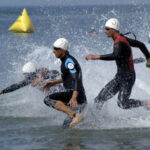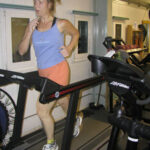There are a lot of things to prepare for in a triathlon which is composed of a swimming, cycling and running leg. In addition, there are also the transitions in between each leg, which are still timed and critical toward achieving a respectable time. Here are the top ten tips for women training for a triathlon:
The Swim
The swim is the first leg of the triathlon, and arguably the most taunting for some competitors. But, it shouldn’t be.
Stay relaxed: You have two legs ahead of you after this. The swim is where you want to take long, careful strokes making sure that you don’t expend too much energy. Move quickly, depending on your personal goals, but make sure to save quite a bit of energy for the following legs.
Be Fully Prepared: Often times, people will come poorly prepared for the swimming event, because in actuality, there are quiet a few things you need to bring. Most importantly, you need goggles. My dad, when he was a triathlete almost a decade ago, forgot his goggles to a race and was practically forced to swim with his head above the water, killing his time. Other things you may need include a swim cap, racing/cycling suit underneath, water bottle, and heart monitor.
The Cycling
The second leg of the swim is where you need to be most careful with your energy because you may be forced to catch up or conserve your energy, depending on the competitors. In addition, this will be the longest and portion of the triathlon in both time and distance.
Sit up Straight: During the cycling leg, only your legs are important, so it’s best you give them all the energy. Keeping your upper body relaxed and sitting up straight can open your chest cavity by nearly 30%, allowing for more oxygen and blood to supply your legs.
Have a Circular Pedal Stroke: Often times, when most of us bike, we lean forward and push down on the pedals. However, for the sake of efficiency, physics disagrees. Instead, you want to make sure that in one pedal stroke, you evenly distribute the amount of force you put into pushing forward just as much as pushing backward.
The Running
This is the last and most difficult part of the triathlon. Here, your energy supplies will have been greatly diminished and almost all of the muscles being used are the same ones used in the previous portion: your legs.
Drink Water: More often than not, the reason why people have difficulty with the running portion is not because lack of energy but because lack of water. When you’re running or during your transition, remember to take small sips of water periodically to keep you hydrated.
Use Your Arms: Most people believe running is all in the legs. In reality, it’s not at all. A lot of running includes good posture and arm movement. More specifically, it’s important you sway your arms and keep them close to your body. This way, you’ll have momentum on your side and you’ll have to waste less energy in your legs.
Transition More Efficiently
It’s important to remember that the clock keeps running even while you’re taking that seemingly restful pit stop between legs of the triathlon. However, those two minutes are the same two minutes that you spend hours training for to cut off your running or swimming time. This time, though, it’s far easier to cut the time during transitions:
Practice the Transition Several Times: The worst thing you can do during your transition is do it incorrectly because you’re losing a lot of time: basically, consider the total transitions a fourth leg. Know your plan and do it quickly to get the fastest time during the “transition leg.”
Use Less Things: The more time you spend dealing with extra items, the slower your final time will be. This means, get rid of anything that doesn’t easily attach to your equipment or bike because you don’t want risk any time juggling it in your hands. This also means wear a wet-suit over your cycling/running suit so that you don’t have fully change your outfit.
No More Shoe Tying: Tying your shoes can eat up a lot of your time, no matter how skilled you are at it. You want to put on your shoes and go. Don’t stick with laces; instead, get lace locks so that you can put your shoes on quick and have them stay in place for the rest of the race.
Do Things on the Move: Standing still during the transition is your worst enemy. Before the actual triathlon, prepare for ways to put on gear while moving or ways to get closer to the actual path.
Sources:
“Tips for Faster Triathlon Transitions.” Run the Planet.
“Triathlon.” Wikipedia.
Mat Leubbers, “Swimming in a Triathlon.” About.com.
Coach Katherine, “Elements of good biking form.” Ontri.
“Your First Triathlon.” Trinidad and Tobago Triathlon Association.




